NVIDIA GeForce GTX 760 Review: The New Enthusiast Kepler
by Ryan Smith on June 25, 2013 9:00 AM ESTPower, Temperature, & Noise
As always, last but not least is our look at power, temperature, and noise. Next to price and performance of course, these are some of the most important aspects of a GPU, due in large part to the impact of noise. All things considered, a loud card is undesirable unless there’s a sufficiently good reason – or sufficiently good performance – to ignore the noise.
With both the 600 series GK104 parts and the GK104 based GTX 770 as a backdrop here, we’re not expecting any great surprises here. Power consumption is going to approach the GTX 670 thanks to GPU Boost 2.0 and the identical TDPs. And since the cooler is also the same, acoustics should also be similar. Only idle power should show any real variation.
| GeForce GTX 760 Voltages | ||||
| GTX 770 Max Boost | GTX 760 Max Boost | GTX 770 Idle | ||
| 1.2v | 1.2v | 0.850v | ||
Like the GTX 770, GTX 760 is spec’d to a stock top voltage of 1.2v. This buys NVIDIA the 1100MHz+ clockspeeds we’re seeing, but it drives up power consumption.
| GeForce GTX 760 Average Clockspeeds | |||
| Max Boost Clock | 1149MHz | ||
| DiRT:S |
1134MHz
|
||
| Shogun 2 |
1127MHz
|
||
| Hitman |
1149MHz
|
||
| Sleeping Dogs |
1139MHz
|
||
| Crysis |
1145MHz
|
||
| Far Cry 3 |
1132MHz
|
||
| Battlefield 3 |
1123MHz
|
||
| Civilization V |
1139MHz
|
||
| Bioshock Infinite |
1131MHz
|
||
| Crysis 3 |
1105MHz
|
||
Looking at the average clockspeeds among our games, despite the official 1033MHz boost clock for GTX 760 always boosts to an average over 1100MHz, with most games boosting to around 1130MHz. The limiting factor here is typically temperatures, which quickly hit 80C at the highest boost bin and its 1.2v operating voltage. A card with a better cooler would likely have no trouble sustaining 1149MHz here.
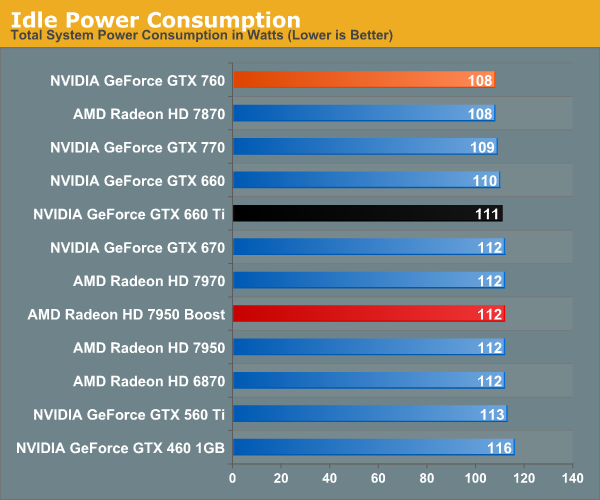
As we saw with the GTX 770 a few weeks ago, NVIDIA’s idle power consumption as measured at the wall has come down a couple of watts compared to the older GK104 cards. With a lower idle clockspeed compared to the GTX 660 Ti and its ilk, NVIDIA has been able to shave off that wattage without any more substaintial changes. However I continue to be surprised that we’re seeing any difference between the GTX 760 and the 7950B, as AMD is no slouch here either.
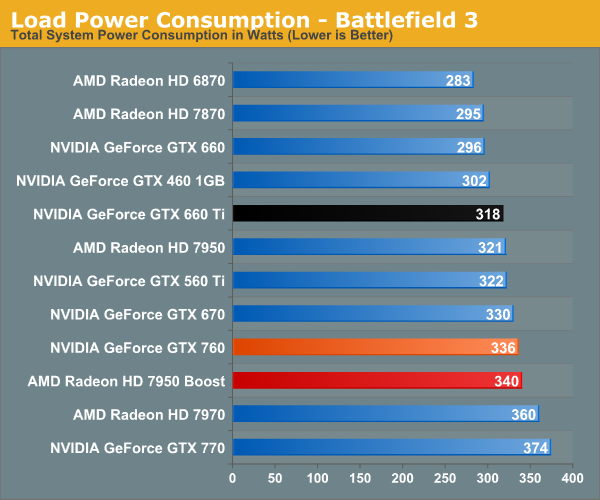
Moving on to load power under Battlefield 3, our results validate our earlier theories on power consumption based on the spec sheets. Wall power with a GTX 760 is 6W higher than GTX 670 in this test, and 18W higher than with a GTX 660 Ti. There’s no getting around the fact that GTX 670-like performance requires GTX 670-like power consumption.
At the same time the power consumption of the GTX 760 is almost identical to the 7950B at the wall. Though given the 7950B’s lower performance in this benchmark, what we’re actually seeing is lower CPU power consumption offsetting the 7950B’s higher power consumption.
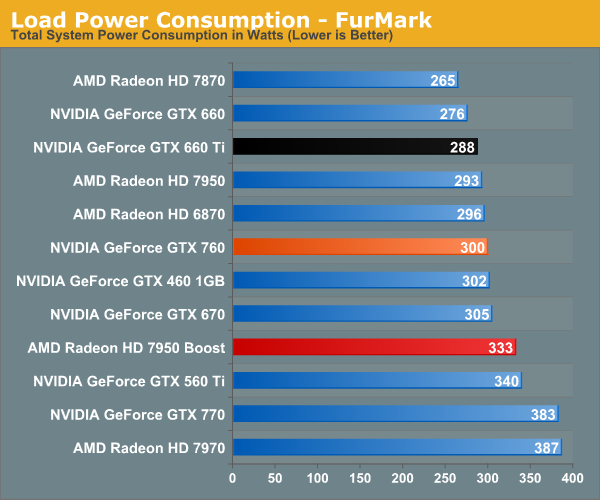
With Furmark the story is fairly similar for the NVIDIA cards, all of which come close together due to their similar TDPs. Meanwhile the 7950B pulls about 30W more at the wall, in-line with its 200W TDP. NVIDIA edged out AMD on power efficiency with the 600 series, and we’re going to see the same thing on the 700 series.
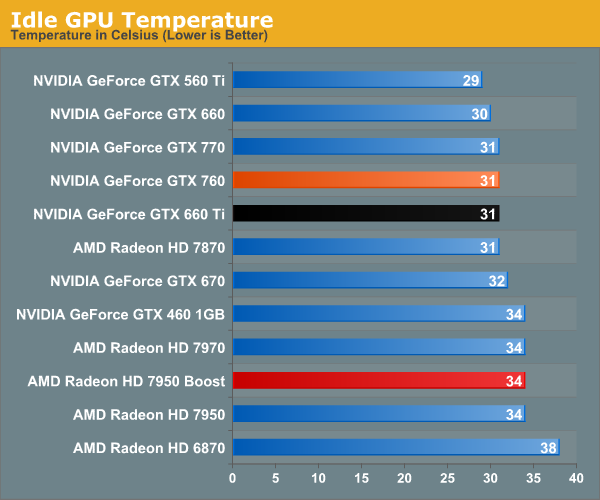
Based on the same cooler and GPU as the GTX 670, the GTX 760 offers no grand revelations here. 31C is standard for this type of blower cooler.
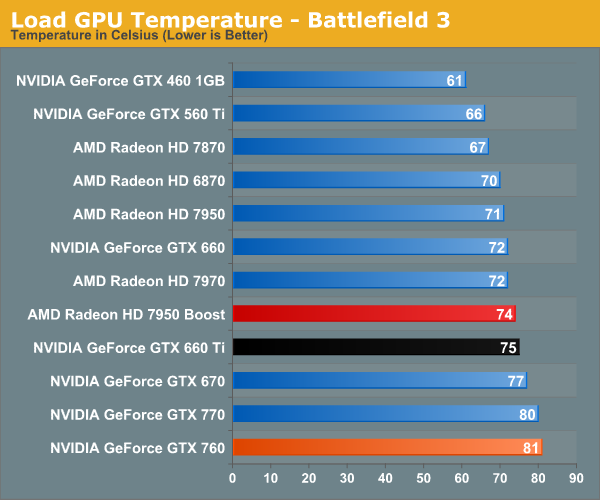
Even though the GTX 760 and GTX 670 have identical TDPs, the presence of GPU Boost 2.0 means that the GTX 760 operates nearer its TDP more often, and in this case the 80C throttle imposed by GPU Boost makes itself felt. 81C does end up being the worst among the cards in this collection, but it’s a reasonable temperature for a GK104 GPU, to the point where in temperature limited scenarios this is exactly where it’s designed to top out at.
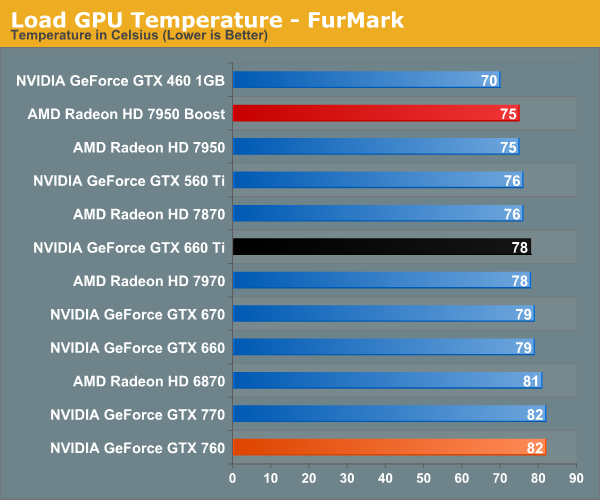
With FurMark our results are much the same as with BF3. The slower response time of the fans on the GTX 770 and GTX 760 mean that both cards top out at 82C before temperatures level out, a few degrees warmer than with the GTX 670 and GTX 660 Ti. Alternatively the 7950B and its more powerful fan keep temperatures at or below 75C for any workload we throw at it.
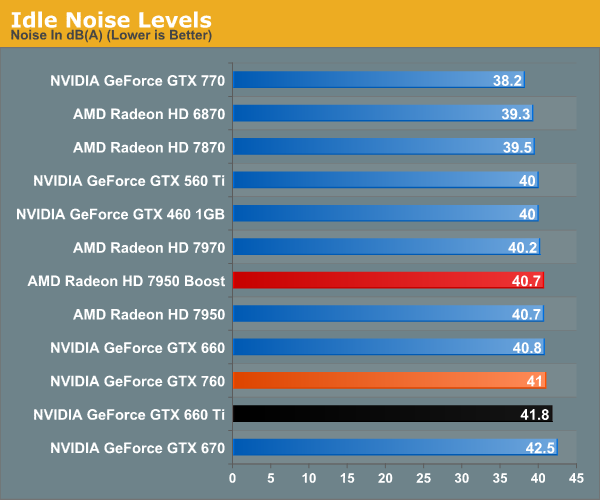
Since NVIDIA used the same cooler/fan assembly as on the GTX 670, the GTX 760 is going to give us similar acoustics. Unfortunately that includes the characteristic faint grinding noise that we’re previously mentioned. Idle noises as a result are respectable, but GTX 770 this is not.
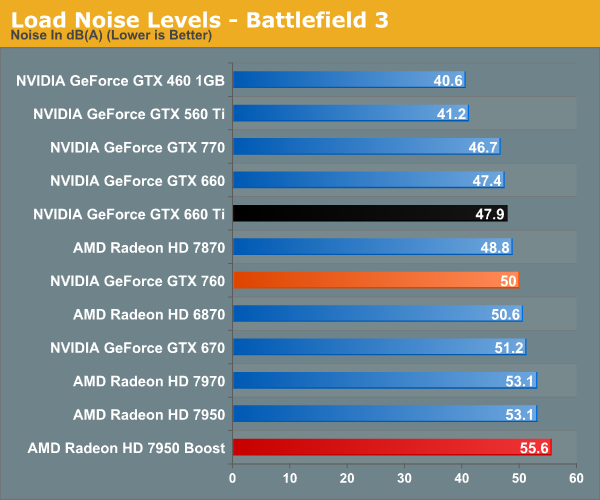
Moving to fan noise under load, here we can see NVIDIA’s default fan curve and 80C throttle once again pay off. The GTX 760 hits 50dB under BF3, which for this specific cooler is actually doing a bit better than average, as evidenced by the slight advantage the GTX 760 has over the GTX 670. The GTX 770 and Fermi cards are something of spoilers here though, a reminder of what the Titan cooler and open air cooling can do. We will have some custom GTX 760s next week, so it will be interesting to see how much better these cards are when it comes to noise. 50dB is by no means bad, especially for the performance, but at this point we’ve seen lower noise levels out of cards with similar price tags and TDPs.
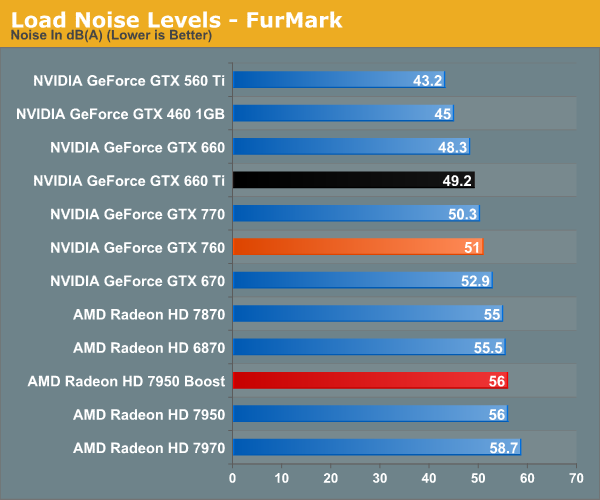
Finally, FurMark once again paints a picture very similar to what we saw with Battlefield 3. For NVIDIA cards this is middle of the road, while at 5dB quieter than the reference 7950B it’s a significant improvement.










110 Comments
View All Comments
Aditya211935 - Tuesday, June 25, 2013 - link
I guess I m a bit early.A5 - Tuesday, June 25, 2013 - link
Looks pretty solid for the price.Samus - Tuesday, June 25, 2013 - link
I feel like an idiot buying a 660Ti two months ago for $300. At least I got the 3GB version that'll be "somewhat" future-proof for BF4 as the maps are expected to tax 2GB cards.gamoniac - Tuesday, June 25, 2013 - link
Don't look back. You can only make your decision based on the information you had and your needs at the time. If you could look just 2 minutes ahead, you would be a billionaire now and wouldn't be participating in this conversation.just4U - Tuesday, June 25, 2013 - link
this is essentially a cheaper 670.. coming it at or below the price of the 660TI. I don't see your purchase as being one of those you think $*!@! over. Hah. Your card is a bit slower but not noticeably so and the added ram may benefit you down the road.Hixbot - Wednesday, June 26, 2013 - link
A cheaper, and slower 670. So not really a 670 at all.just4U - Tuesday, June 25, 2013 - link
I'd agree.. although pricing here is 275-300.. Don't see any at 249. The 7950 is 300.. They will have to lower that down a tiny bit to be competitive I think, take a small hit in performance (but more ram possible benefit later?) and their games bundle the trade off for consumers should be about equal.Lovolt - Wednesday, June 26, 2013 - link
Not sure where 'here' is, but newegg has 3 models at $250 and another 6 at $260 (on June 26).just4U - Thursday, June 27, 2013 - link
Calgary Canada.. We have a newegg.ca but it's not as good as your newegg I think that's to do with taxation and not having a actual warehouse here.ericore - Tuesday, July 2, 2013 - link
No, they have warehouses in Canada; if you've ever ordered a big order you'd realize this since not everything ships at once; comes from different warehouses in Vancouver, Mississauga and several others. They charge us more because they can, but only charge more on certain items so that we can't revolt. Generally the can prices are very close to the US ones, but the odd time they are significantly more. Processing and taxes are also cheaper in the US, but we do get the crappy end of the stick at times. There was a specialty motherboard, on newegg.com this was 100, and newegg.ca this was 150; can't remember the model.